Sussex County, New Jersey
Sphingidae
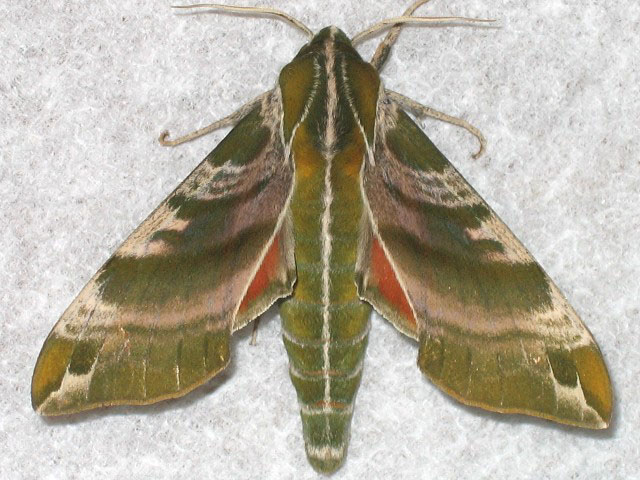
Darapsa versicolor Newton, Sussex County, New Jersey, courtesy of Joe Garris.
This site has been created by Bill Oehlke.
Comments, suggestions and/or additional information/sightings are welcomed by Bill.
|
|
Updated as per James P. Tuttle's The Hawk Moths of North America, September 5, 2008 Updated as per personal communication with Joe Garris, July 23, 2012; Sphinx poecila; June 6, 2015; Sphinx franckii, July 9, 2019; Xylophanes tersa, August 21, 2019; Hyles lineata, August 30, 2019; July 2021 |

This site has been created by Bill Oehlke.
Comments, suggestions and/or additional information/sightings are welcomed by Bill.
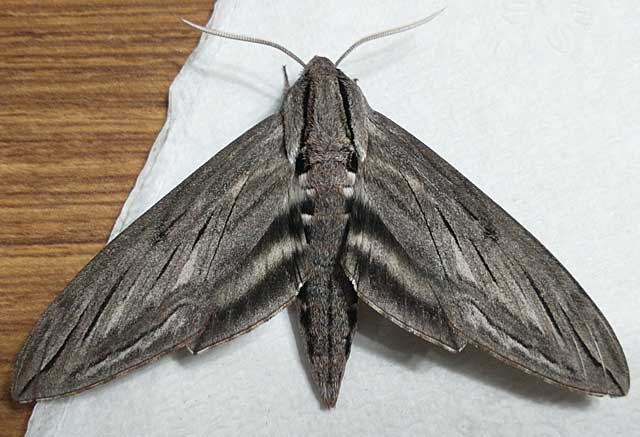
Sphinx chersis, Stillwater, Sussex County, New Jersey,
July 18, 2021, courtesy of Joe Garris.
Joe has recently (June 5, 2015) confirmed Sphinx poecila in Sussex County. Even more recently July 9, 2019, Joe confirms Sphinx franckii in Stillwater, Sussex County.
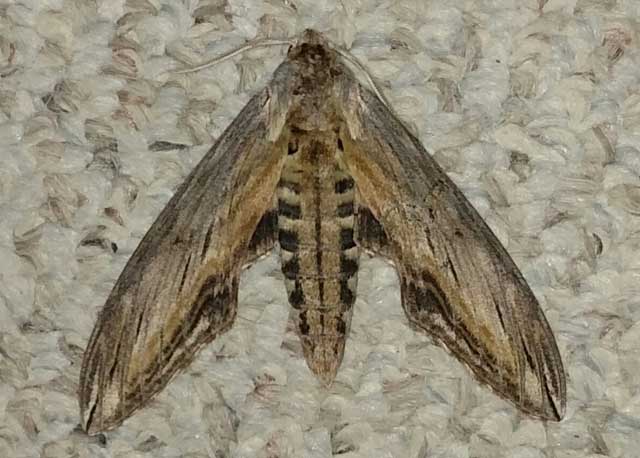
Sphinx franckii, Stillwater, Sussex County, New Jersey,
July 9, 2019, courtesy of Joe Garris.
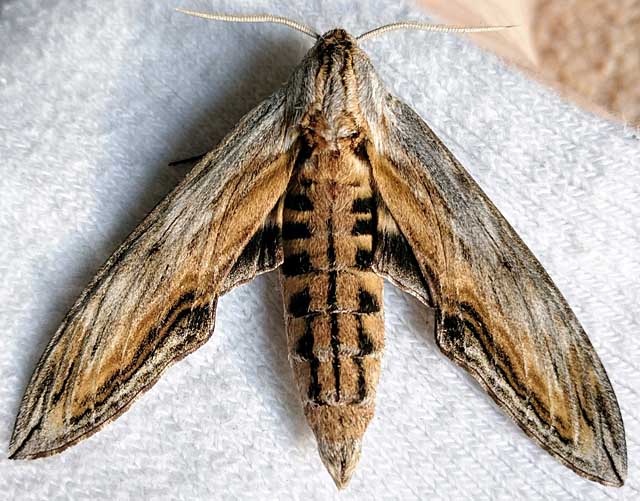
Sphinx franckii, Stillwater, Sussex County, New Jersey,
July 18, 2021, courtesy of Joe Garris.
"The species that really amazes me though is Eacles imperialis! A few years ago they were non-existent here in Stillwater NJ. Now, as of this summer of 2019, I've recorded 139 at the lights from late June through early August. In fact they're by far the most common big silkmoth at the light (not including rosies). My record this year of Citheronia regalis makes me wonder if I'll be seeing them more commonly in the future."
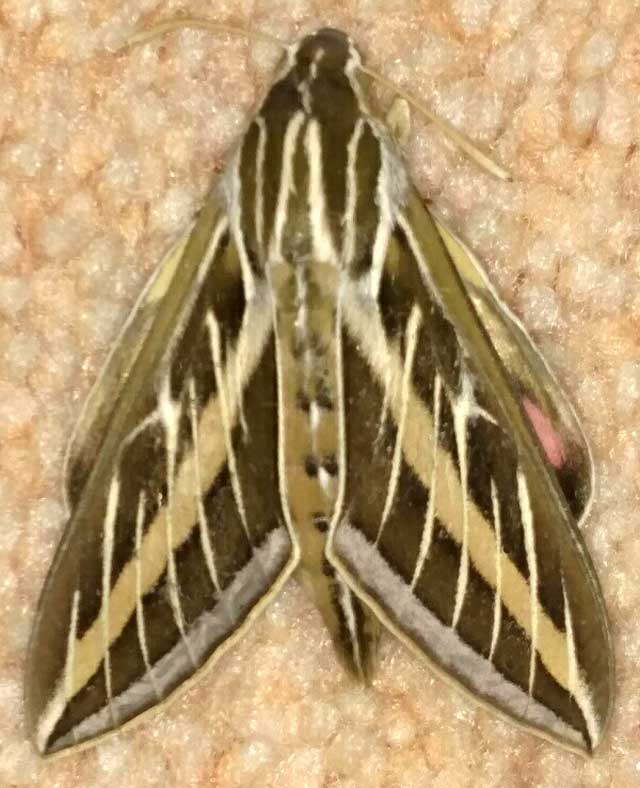
Hyles lineata, Stillwater, Sussex County, New Jersey,
August 30, 2019, courtesy of Joe Garris.
Many thanks to Jeff Swick who has recently provided some beautiful images of Sphingidae nectaring at bouncing bet.
Jeff writes, "I have looked at your wonderful website many times! What a great source of information! Over the past summer, I became fascinated with photographing sphinx moths while nectaring at a large stand of bouncing Bet (Saponaria officinalis) growing wild in northern New Jersey (Flatbrookville, Sussex County). I tentatively identified and photographed about 6-7 species over the course of three weeks in July. I thought that I would share a few photos. Feel free to use them in any way that you wish. Keep up the incredible efforts with your site!"
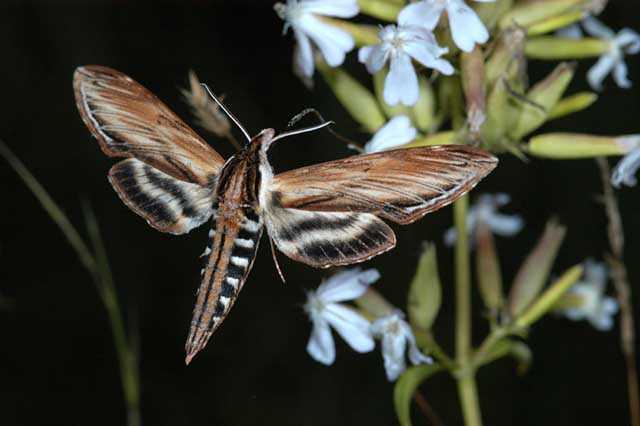
Sphinx kalmiae nectaring at bouncing bet, Flatbrookville, Sussex County, New Jersey,
July 2008, courtesy of Jeff Swick.
Forty-four Sphingidae species are listed for New Jersey on the U.S.G.S. website, now BAMONA). Not all of the species are reported or anticipated in Sussex County (eight are reported on U.S.G.S.). It is hoped that this checklist, with the thumbnails and notes, will help you quickly identify the moths you are likely to encounter.
A "WO" after the species name indicates that I (William Oehlke) expect that this moth is present or might be present, although unreported.
A "JG" indicates the moth is reported by Joe Garris. A "TM" indicates the moth is reported by Tony McBride.
Please help me develop this list with improved, documented accuracy by sending sightings (species, date, location), preferably with an electronic image, via email to Bill Oehlke.
Visit Sussex County Sphingidae Larvae: Caterpillars; Hornworms
Visit New Jersey Catocala: Underwing Moths
If you are travelling, you can find active Sphingidae checklists for all countries in North, Central, and South America and the Caribbbean via the links at
North, Central, South American Sphingidae checklists
Sphinginae subfamily
In 2011 I had 11 Dolba hyloeus show up, 3 in 2012 then none until 2018 when I got 1, Joe Garris Dolba hyloeus, Flatbrookville, July, 2008, courtesy of Jeff Swick
Manduca sexta, Flatbrookville, July 2008, courtesy of Jeff Swick
Sphinx kalmiae, Flatbrookville, July, 2008, courtesy of Jeff Swick
Smerinthini Tribe:
Pachysphinx modesta, September 15, 2006, courtesy of Joe Garris.
Paonias excaecata, September 15, 2006, courtesy of Joe Garris.
Macroglossinae subfamilyDilophonotini tribe:
See Hemaris comparison to help distinguish the next three species.
Hemaris thysbe, Sussex County, September 15, 2006, courtesy of Joe Garris.
Philampelini tribe:
Eumorpha pandorus, Flatbrookville, July 2008, courtesy of Jeff Swick.
Macroglossini tribe:
Darapsa choerilus September 15, 2006, courtesy of Joe Garris
Darapsa myron September 15, 2006, courtesy of Joe Garris.
Xylophanes tersa, probably an adult stray from further south, Stillwater, |
Enjoy some of nature's wonderments, giant silk moth cocoons. These cocoons are for sale winter and fall. Beautiful Saturniidae moths will emerge the following spring and summer. Read Actias luna rearing article. Additional online help available.
Use your browser "Back" button to return to the previous page.
This page is brought to you by Bill Oehlke and the WLSS. Pages are on space rented from Bizland. If you would like to become a "Patron of the Sphingidae Site", contact Bill.
Please send sightings/images to Bill. I will do my best to respond to requests for identification help.
 Show appreciation for this site by clicking on flashing butterfly to the left. The link will take you to a page with links to many insect sites. |
I very much appreciate all the many images that have been sent to me, or of which I have been granted permission to copy and post from other websites. All images on this site remain the property of respective photographers.
If you would like to contribute to the maintenance of this website by sending a contribution to
Bill Oehlke
Box 476
155 Peardon Road
Montague, Prince Edward Island, C0A1R0
Canada
your donation would be much appreciated and would be used for
1) paying for webspace rental;
2) paying for computer maintenance and software upgrades;
3) purchases of additional text reference material (journals and books) in anticipation of expanding the site to a worldwide Sphingidae site;
4) helping to pay my daughter's tuition (completed spring 2013); with anything left over going to humanitarian aid.
If you are mailing a check from USA, please use $1.25 postage. ($1.25 is 2019 rate so check with post office as rates seem to be rising almost annually.) Donations can also be made through Paypal via the button below.